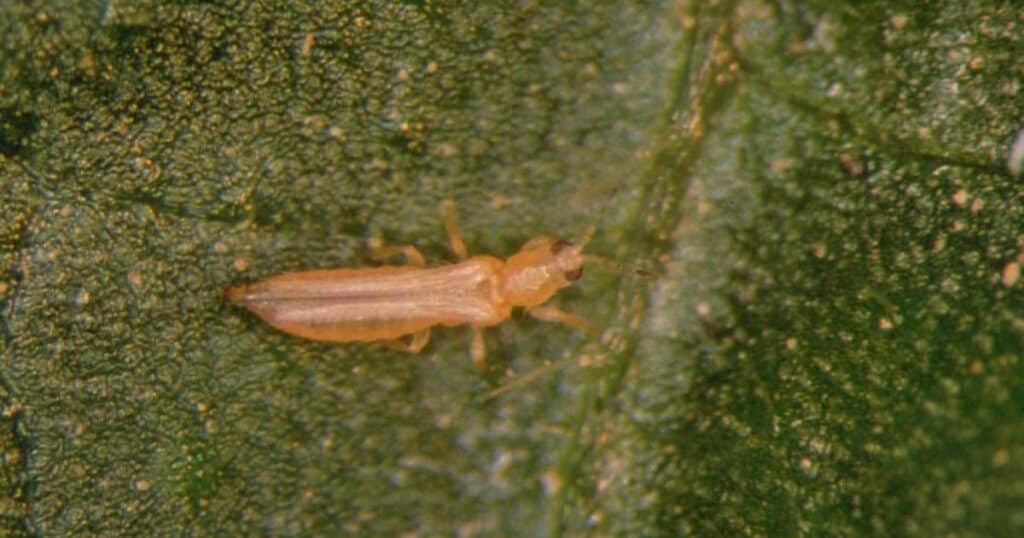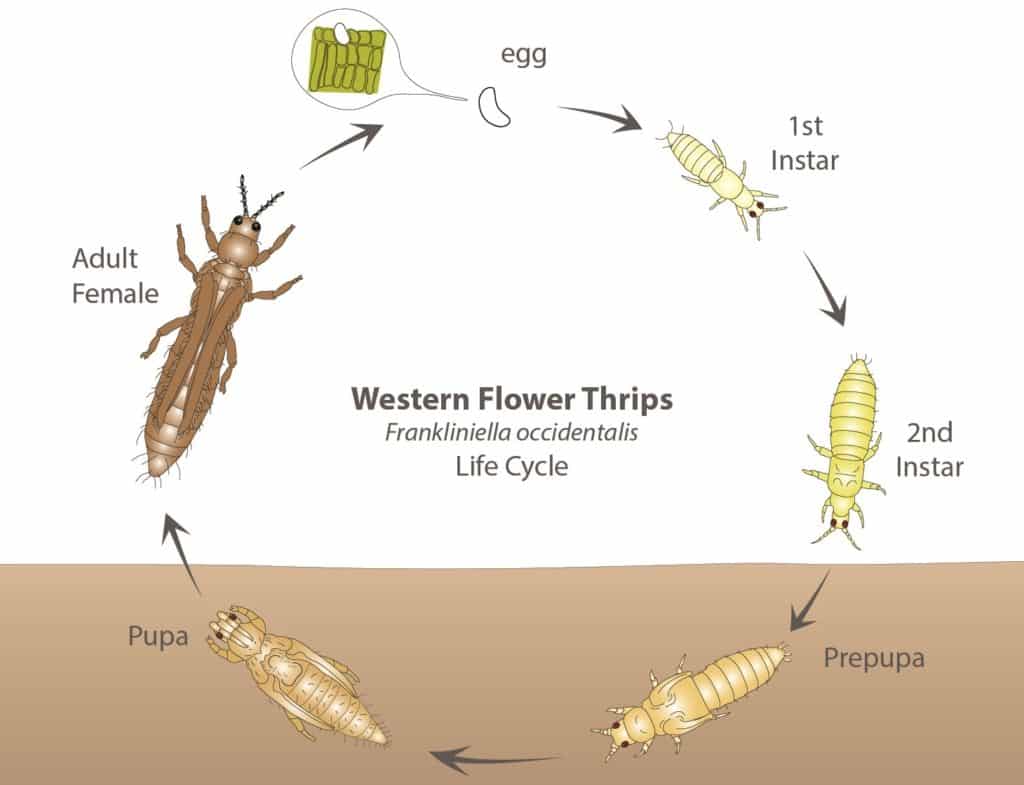Of the 6,000+ species of thrips documented, much less than 1% are agricultural pests. Perhaps a few dozen pests cause mild to moderate damage on one or a few crop species, but only between a few dozen species are known for largescale damage across many crops. No species is as well-documented as Frankliniella occidentalis, the Western Flower Thrips, on which around half of recent thrips literature is focused.
Three main factors contribute to its provenance: a wide host range including hundreds of cultivated and wild plants, small thin bodies that allow for easy movement in the air or nestled in the crevice of a transported plant, and high levels of resistance to plant defenses as well as various treatment compounds and environments.

While thrips damage is not usually lethal, large populations severely reduce photosynthetic rate, stunting growth. Such “stippling” wounds are scrapes in primarily leaf tissue that liberate cell contents which thrips then imbibe, often leaving black liquid flecks as excrement at or near the damage, which is somewhat unique to them.
Damage to foliage or flower can make plants or their yield undesirable. For example, footage and other references about Western Flower Thrips biology and treatment specific to Cannabis, check out my video on the subject (https://youtu.be/QxGzxie8ano).
Western Flower Thrips have a small yellowish cigar-shaped body a few millimeters in length that has feathery wings if an adult and lacks them as larvae. This thin body that tapers at both ends is often seen patrolling the middle vein on top of leaves or the succulent tissue on the bottom sides, among others and their collective damage. In transplants, not only of Cannabis but household plants and commercial vegetables, these thrips can establish somewhat covertly.
In fact, Western Flower Thrips deposit eggs into the surface of plant leaves, making them invisible to detection. After hatching, they appear as small yellow rods as they move and grow. They have a dormant state, often simply called a pupa though it doesn’t protect itself in silk or another casing but does cease movement and commonly drops to the substrate or floor.
At this stage, soil predators and other control measures can be applied to break this vulnerable link in the life cycle before the highly mobile adults emerge. Popular options are Steinernema feltiae nematodes and Stratiolaelaps/Hypoaspis soil predatory mites.

Generally, thrips treatment and prevention are more manageable in more sheltered conditions like greenhouses and indoor spaces, while outdoor environments are more complicated. This is mainly because thrips rapidly build up in the environment, and this super generalist species, in particular, can establish on many natural plants.
Annuals are particularly suitable, and many adults engorge on pollen, providing females with extra protein for egg production. When these plants die, large populations essentially swarm, looking for viable hosts far and wide. As natives of western North America, they are drought tolerant to a degree, and encountering artificially well-irrigated crops in an arid, hot environment is extremely attractive.
Large populations constantly visit the same crop despite cultivators detecting and responding accordingly, making their constant presence in certain contexts a massive resource sink of time, money, and labor.
There are many solutions for Western Flower Thrips at different scales, including commercially available biocontrols such as Cucumeris and Whirligig predatory mites, chemical agents like micronized sulfur, and even unique insect screens explicitly made for them: thrips screens.
Individually, thrips are not very damaging nor hardy aside from their toxin and plant defense resistance. This means that some products that rely on targeted toxins be they chemicals or microbial byproducts, can select for resistance traits by affecting susceptible groups and not those with helpful mutations.
Rotating between products and integrating multiple approaches is an important aspect of holistic pest management. Dealing with small infestations that push through many layers of passive and active defense to settle is more manageable than contending with multiple thousands per week. Physical barriers, generalist predatory mites, and a vigilant scout team can severely curtail the brunt of a midsummer Thripspocalypse.
You can follow Matt and learn more about proper IPM methods @synchangel on IG
Looking for more info on sustainable growing methods? Check out our Higher Learning series on Regenerative Farming HERE!
Enjoyed that first hit? Come chill with us every week at the Friday Sesh for a freshly packed bowl of the week’s best cannabis news!
















